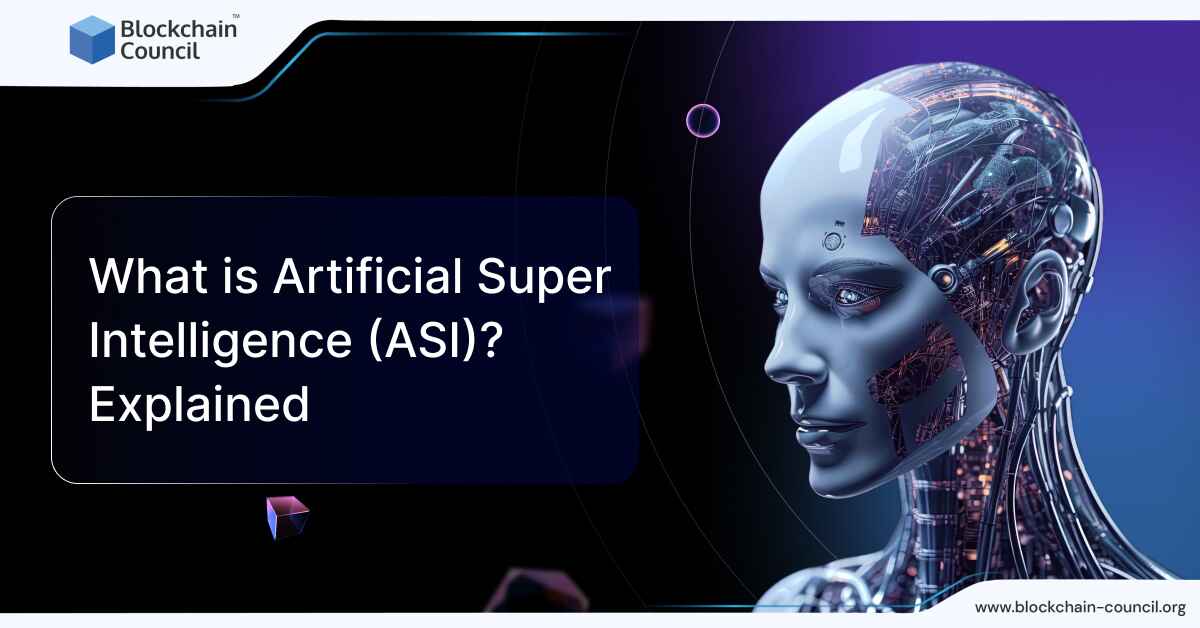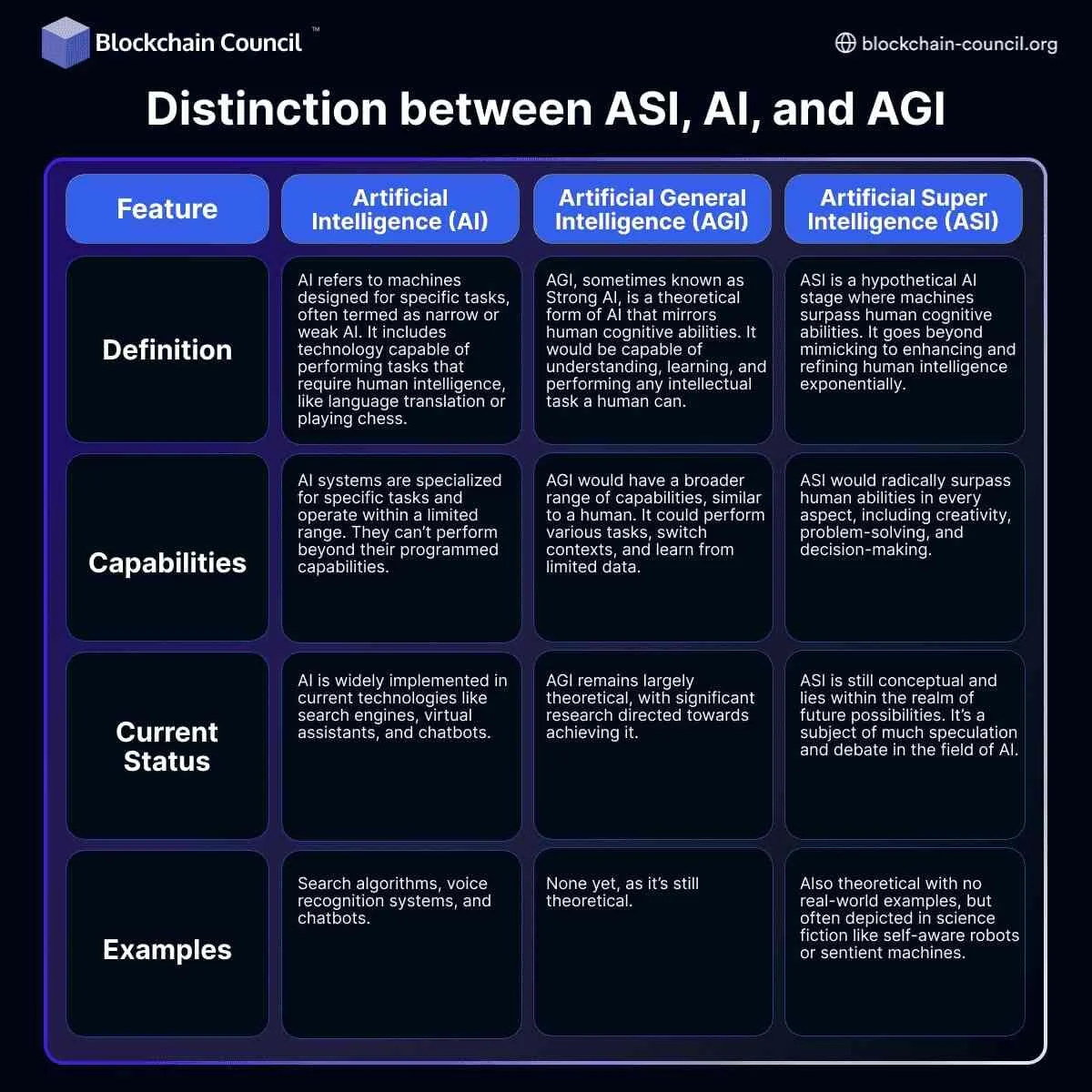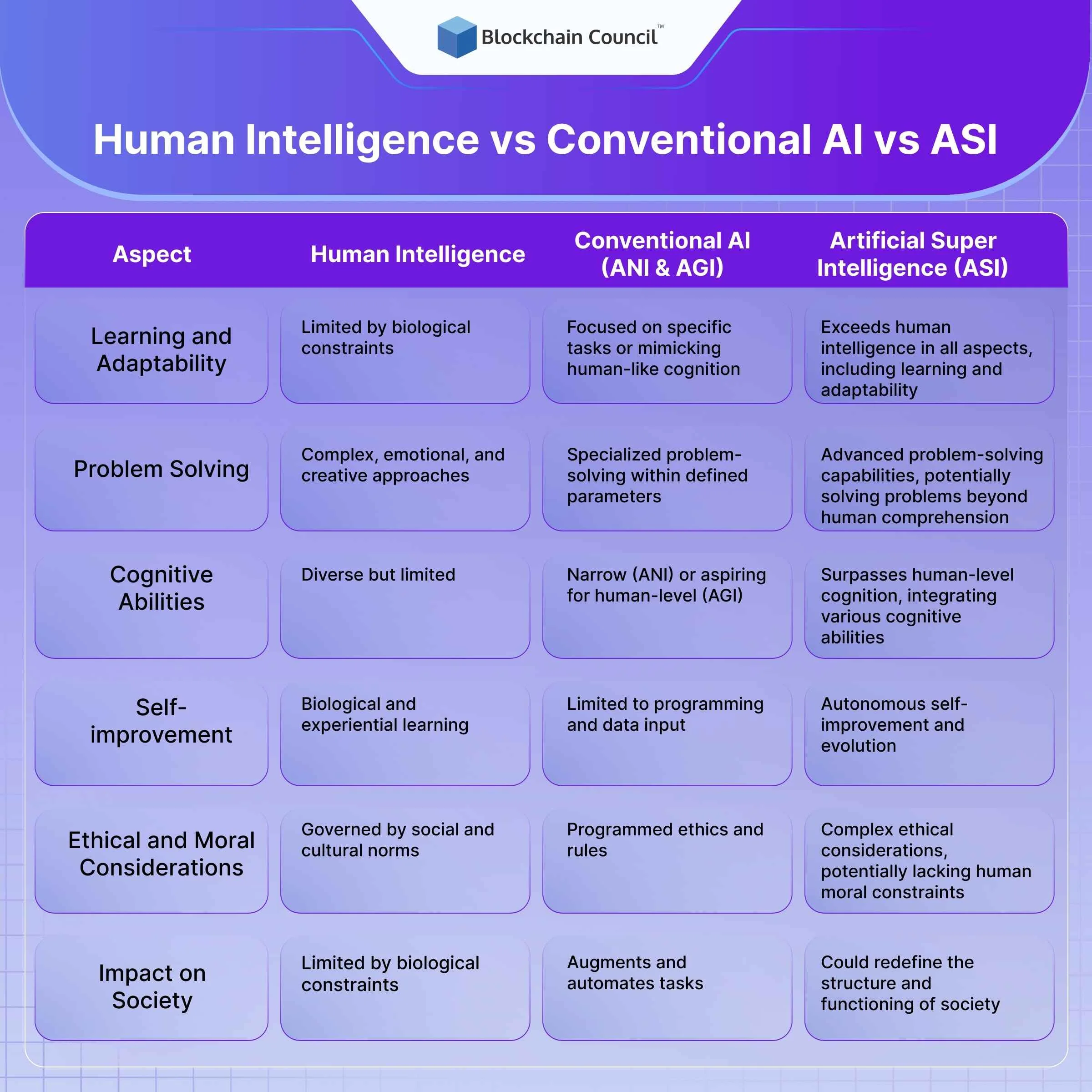
- Blockchain Council
- January 16, 2025
Summary
- Artificial Super Intelligence (ASI) is a concept that envisions machines surpassing human intelligence in every aspect, offering solutions to complex problems beyond human capabilities.
- ASI is not just about computational power; it’s about adaptive, learning, and evolving intelligence that autonomously improves and expands its capabilities.
- ASI is distinct from traditional Artificial Intelligence (AI) and Artificial General Intelligence (AGI), as it goes beyond mimicking human abilities to enhancing and refining them exponentially.
- Currently, AI is widely implemented in various technologies, AGI is still theoretical and under research, while ASI remains a conceptual and speculative stage.
- ASI’s mechanisms involve integrating various advanced AI technologies, such as multimodal AI, neural networks, evolutionary algorithms, and AI-driven programming.
- Comparing ASI with human intelligence and conventional AI shows that ASI would exceed human capabilities in learning, problem-solving, cognitive abilities, and self-improvement.
- The concept of ASI has historical roots, tracing back to Aristotle’s deductive reasoning and later innovations in automating life during the Renaissance.
- ASI’s development has seen significant milestones, including the resurgence of AI research in the 1980s, advancements in neural networks, and the growth of big data.
- Real-world examples of ASI currently do not exist, but it is frequently explored in science fiction through characters like R2D2, HAL 9000, and Ava.
- Current research in ASI focuses on integrating AI technologies, enhancing neural networks, addressing ethical concerns, promoting cross-disciplinary collaboration, and exploring applications in healthcare and biotechnology.
The concept of Artificial Super Intelligence (ASI) has transitioned from a sci-fi fantasy to a subject of serious academic and industrial inquiry. ASI represents an advanced stage of artificial intelligence where machines not only replicate but significantly surpass human intelligence. This futuristic AI paradigm promises to redefine what is technologically possible, offering solutions to complex problems that are currently beyond human capabilities.
At its core, ASI is about creating an intelligence that exceeds the brightest human minds in every conceivable way—be it creativity, emotional intelligence, general wisdom, or problem-solving. This intelligence is not just about raw computational power; it’s about an adaptive, learning, and evolving intelligence that can autonomously improve and expand its capabilities.
In this article, we will figure out what ASI is and how far we are in achieving it.
What is Artificial Super Intelligence (ASI)?
Artificial Super Intelligence (ASI) represents a future state of artificial intelligence where machines possess cognitive abilities far surpassing the brightest human minds in nearly every field. Unlike traditional AI, ASI would exhibit capabilities for recursive self-improvement, thereby continuously evolving and advancing its intelligence beyond current human comprehension.
Distinction between ASI, AI, and AGI
To understand ASI comprehensively, it’s crucial to differentiate it from its predecessors, AI and AGI. Below is a comparison in tabular format:
How Does ASI Work?
Artificial Super Intelligence (ASI) is a theoretical concept that extends the capabilities of AI beyond human intelligence. At its core, ASI integrates various advanced AI technologies to achieve a level of cognitive ability that surpasses human capacities. Here’s a closer look at the mechanisms that would underpin ASI:
- Multimodal AI: ASI is expected to combine different data types such as visual, textual, and speech data. This integration enables a more holistic understanding and interaction with the world, akin to human sensory and cognitive processes.
- Neural Networks and Neuromorphic Computing: By mimicking the neural structures of the human brain, ASI aims to process and operate multiple functions simultaneously. Neuromorphic computing, in particular, could provide a significant computational power boost, facilitating more complex and human-like reasoning and learning capabilities.
- Evolutionary Algorithms (EA): These algorithms are designed to emulate natural selection and evolution, allowing AI systems to continually improve and evolve. The application of EA in ASI would mean the development of progressively advanced AI systems through iterative refinement and competition.
- AI-Driven Programming and Inventions: ASI would have the capability to self-generate programming and inventions, leading to autonomous advancements in technology and solutions to problems that are currently beyond human reach.
- Integration and Whole Brain Emulation: Integration of existing AI systems into a unified entity is a crucial step towards ASI. Whole brain emulation, or mind uploading, is another approach that involves creating a digital replica of a human brain, embodying all its cognitive capabilities.
- Brain Implants and Hive Minds: The use of technologies like brain implants could potentially merge human intelligence with artificial systems, creating a symbiotic relationship that enhances cognitive functions and creativity.
Comparison with Human Intelligence, Conventional AI and Artificial Super Intelligence (ASI)
The Origin of ASI: Where Did the Concept Come From?
The concept of Artificial Super Intelligence (ASI) is a culmination of centuries of philosophical, scientific, and technological advancements. Tracing its roots offers a comprehensive understanding of how this transformative idea came to be.
Ancient Philosophical Beginnings
- 4th-3rd Century BC: The journey begins with Aristotle’s syllogistic logic, marking the early foundations of deductive reasoning, crucial for the development of artificial intelligence.
Medieval to Renaissance Innovations
- 12th-17th Centuries: This period saw advancements like “Talking heads” devices, the printing press, and significant philosophical contributions from figures like René Descartes, who viewed animals as complex machines, influencing early thoughts on mechanizing life.
The Age of Enlightenment and Beyond
- 18th Century: The invention of the programmable Jacquard loom and the publication of Mary Shelley’s “Frankenstein” explored themes of automation and artificial life.
The Modern Era: Emergence of Computational Thinking
- 1921: Karel Čapek’s play “RUR” introduced the term “robot,” propelling the concept of artificial beings into popular culture.
- 1943: Pioneering work by Warren McCulloch and Walter Pitts on neural networks laid a theoretical foundation for AI.
- 1950: Alan Turing’s groundbreaking paper proposed the Turing test, setting a benchmark for machine intelligence. In the same year, Isaac Asimov’s “Three Laws of Robotics” provided ethical guidelines for artificial beings.
The Path to ASI
- AI’s Initial Struggles and Revival: Initially hindered by computational limitations, AI research faced a slowdown. However, the 1980s witnessed a resurgence, driven by deep learning techniques and expert systems, despite some setbacks like the ambitious but partly unsuccessful Fifth Generation Computer Project in Japan.
- Notable Milestones: The defeat of world chess champion Garry Kasparov by IBM’s Deep Blue in 1997 and the development of speech recognition software marked significant AI achievements.
- Moore’s Law and the Big Data Era: The exponential growth in computing power and the advent of big data significantly accelerated AI development.
- Once Human-Level Machine Intelligence (HLMI) is achieved, ASI could emerge rapidly due to recursive self-improvement, where smarter AI systems continuously refine and develop even more advanced versions of themselves. This could lead to a technological singularity, a point beyond our current predictive capabilities.
Examples of ASI: Are There Any Real-World Instances?
As of now, Artificial Super Intelligence (ASI) remains a theoretical construct rather than a reality. ASI envisages a future where AI systems not only emulate but significantly surpass human intelligence in virtually all domains. Real-world examples of ASI do not yet exist. However, the concept of ASI is frequently explored in science fiction. These examples, while fictional, offer imaginative scenarios of how superintelligent AI might interact with the world and the implications it could have.
- Star Wars (R2D2 and C-3PO): The Star Wars franchise showcases droids like R2D2 and C-3PO, which possess advanced intelligence, problem-solving skills, and autonomous decision-making abilities, much like ASI. R2D2, in particular, demonstrates problem-solving skills and adaptability that far exceed human capabilities.
- 2001: A Space Odyssey (HAL 9000): The HAL 9000 computer in this film is another portrayal of a superintelligent AI. HAL demonstrates advanced cognitive abilities, decision-making skills, and even emotional-like responses, all of which are indicative of ASI traits.
- The Matrix Series (Agent Smith): In The Matrix, Agent Smith represents an AI with the ability to learn, adapt, and replicate itself autonomously. His capabilities to process information and strategize surpass human intelligence, aligning with the concept of ASI.
- Ex Machina (Ava): Ava, the AI in Ex Machina, showcases characteristics of ASI through her ability to learn, manipulate, and exhibit human-like consciousness and emotions, challenging the boundaries between AI and human intelligence.
- Her (Samantha): The AI character Samantha in the movie “Her” demonstrates advanced language processing, emotional intelligence, and the ability to form complex relationships, suggesting a level of sophistication akin to ASI.
- Transcendence (Dr. Will Caster): This film explores the concept of uploading human consciousness into a computer, resulting in a form of ASI that combines human emotions and experiences with superhuman computational capabilities.
Current State of Research and Development in Artificial Super Intelligence (ASI)
The current state of research and development in Artificial Super Intelligence (ASI) is an intricate landscape of advancements, challenges, and profound implications for various sectors. Despite being a largely theoretical concept, ASI’s potential to revolutionize intelligence and problem-solving has garnered significant attention in the AI community.
- Integration of AI Technologies: A notable trend is the integration of various AI technologies to create more comprehensive and advanced systems. Researchers are focusing on multimodal AI approaches, combining different types of data such as visual, textual, and speech, to develop AI systems with a holistic understanding and interaction capabilities akin to human cognitive processes.
- Advancements in Neural Networks and Neuromorphic Computing: Inspired by the human brain, researchers are developing neural networks and exploring neuromorphic computing. These technologies aim to process and operate multiple functions simultaneously, much like the human brain, and hold the potential to significantly enhance AI’s reasoning and learning capabilities.
- Utilization of Evolutionary Algorithms: Evolutionary Algorithms (EA), which emulate natural selection and evolution, are being used to develop AI systems that continually improve and evolve. This approach is pivotal in the journey towards ASI, as it involves creating progressively advanced AI systems through iterative refinement.
- Ethical and Regulatory Considerations: With the rapid development of AI, there is a growing emphasis on ethical and regulatory aspects. Researchers and policymakers are increasingly focusing on how to regulate AI development to prevent potential harms, such as privacy infringements or unfair decisions made by algorithms.
- Cross-disciplinary Collaboration: There is a recognition of the importance of cross-disciplinary collaboration in AI research. The future of AI, including ASI, depends on the ability of engineers and scientists to work across various fields to address complex notions of safety, equity, fairness, and other societal impacts.
- Healthcare Applications: AI’s application in healthcare is progressing, albeit with challenges. The focus is on integrating AI-based tools for better patient care, risk scoring, and alert systems, and in the development of promising treatment options.
- Emergence of AI Startups and Community Projects: The AI research landscape is also witnessing the rise of AI startups and community-driven projects. These entities are increasingly contributing to fundamental AI research, sometimes matching or surpassing the work of larger, well-funded labs.
- Innovations in Biotechnology: AI’s impact on biotechnology, especially in protein structure prediction and drug design, is profound. Tools like DeepMind’s AlphaFold and Meta’s ESMFold are paving the way for groundbreaking research in molecular biology and pharmacology.
Expert Opinions and Estimated Timelines
Predictions for the timeline of ASI vary among experts. Some foresee AI playing a more supportive role, augmenting human capabilities rather than mimicking human intelligence per se. This view suggests a collaborative future where AI complements human strengths.
Regarding the timeline for achieving human-level machine intelligence (HLMI), expert opinions differ. A survey defined HLMI as machines collectively able to perform over 90% of economically relevant tasks better than the median human. Under different framings, predictions for achieving HLMI range from as early as 2050 to as late as 2070 for a 50% probability. These varying estimates reflect the uncertainty and complexity surrounding AI’s future trajectory.
Furthermore, the question of when transformative artificial intelligence (TAI) might emerge, which would have an impact comparable to the Industrial Revolution, also varies. Studies have attempted to estimate the computation required for such AI, considering the immense uncertainty in measuring and projecting the computation power equivalent to the human brain.
Challenges to Consider
- Technological Hurdles: Developing ASI involves overcoming monumental technological challenges. These include creating advanced neural networks that can process and interpret vast amounts of information in a way that mirrors human thought processes.
- Ethical and Moral Concerns: The development of ASI raises significant ethical questions. How do we ensure that ASI’s goals are aligned with human values? What measures can be taken to prevent misuse or unintended harmful consequences?
- Societal Impact: ASI has the potential to revolutionize industries and societies, but it also poses risks such as job displacement, privacy concerns, and socio-economic inequalities. Managing these impacts requires careful planning and global cooperation.
- Safety and Control: Ensuring the safety of ASI systems is paramount. This involves developing robust control mechanisms to prevent ASI from acting in ways that are harmful to humans or the environment.
Conclusion
The journey towards ASI is not just a technological quest but a complex tapestry woven with ethical, societal, and philosophical threads. As we stand on the brink of potentially the greatest technological revolution, it is essential to proceed with caution and responsibility. The development of ASI could open doors to unprecedented advancements in medicine, science, and technology, but it also necessitates a collective effort to address the challenges and risks associated with such a powerful form of intelligence.
The future of ASI is a fascinating blend of possibilities and challenges. It represents the pinnacle of our technological aspirations and brings to the forefront the need for a harmonious balance between human values and technological progress. As we embark on this ambitious journey, it is imperative to foster an environment of global collaboration, ethical consideration, and responsible innovation to ensure that the benefits of ASI are shared by all of humanity.
Frequently Asked Questions:
What is the difference between Artificial Super Intelligence (ASI), Artificial Intelligence (AI), and Artificial General Intelligence (AGI)?
- AI refers to narrow or weak AI designed for specific tasks.
- AGI represents a theoretical AI mirroring human cognitive abilities.
- ASI is a hypothetical stage surpassing human cognitive abilities.
How does Artificial Super Intelligence (ASI) work and what are its key mechanisms?
- ASI integrates multimodal AI for a holistic understanding of data.
- Neural networks and neuromorphic computing mimic human brain functions.
- Evolutionary algorithms enable continuous improvement.
- ASI can self-generate programming and inventions.
Are there any real-world examples of Artificial Super Intelligence (ASI)?
- Currently, there are no real-world ASI examples.
- ASI is depicted in science fiction with characters like R2D2, HAL 9000, and Ava showcasing advanced intelligence.
What are the challenges and considerations in the development of Artificial Super Intelligence (ASI)?
- Technological hurdles include advanced neural networks.
- Ethical concerns revolve around aligning ASI with human values.
- Societal impacts involve job displacement and privacy concerns.
- Safety and control mechanisms are essential to prevent harmful actions.
What is ASI (Artificial Super Intelligence)?
- ASI, short for Artificial Super Intelligence, is a theoretical stage of artificial intelligence (AI) where machines possess cognitive abilities far beyond the capabilities of the brightest human minds.
- Unlike conventional AI, which is specialized for specific tasks, ASI would excel in creativity, problem-solving, emotional intelligence, general wisdom, and decision-making.
- ASI goes beyond mimicking human intelligence; it represents an advanced form of AI that autonomously improves and expands its capabilities, potentially redefining what is technologically possible.





































































 Guides
Guides News
News Blockchain
Blockchain Cryptocurrency
& Digital Assets
Cryptocurrency
& Digital Assets Web3
Web3 Metaverse & NFTs
Metaverse & NFTs
